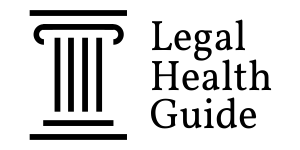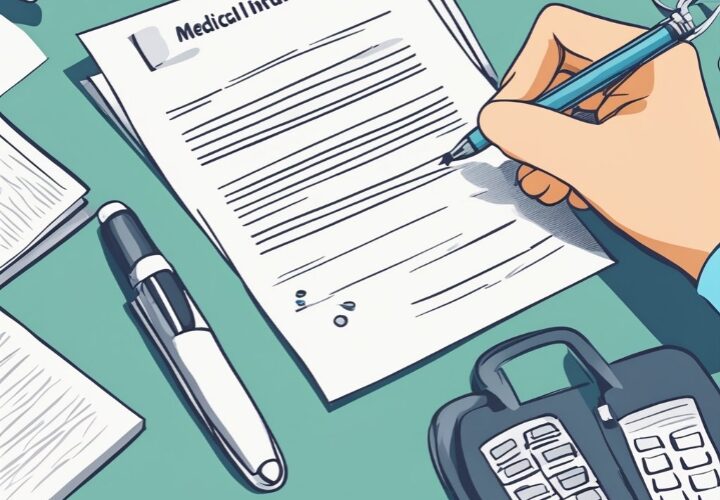When you need money back for medical bills, a medical insurance claim letter can help. This letter tells your insurance company about the care you got and asks them to pay you back. A well-written claim letter can speed up your reimbursement and make sure you get all the money you’re owed.
Writing a good claim letter takes some work. You need to give all the right info and follow the rules. This includes your policy number, the date you got care, and how much it cost. You also need to send in your bills and any other papers that show what happened.
It’s smart to keep track of when you send your letter and any talks you have with the insurance company. If they say no at first, you can ask them to look at your claim again. Being clear and polite in your letter can help you get what you need.
Key Takeaways
- Your claim letter should include all necessary details about your medical care and costs.
- Send in your bills and other supporting documents with your letter.
- Keep records of your communications with the insurance company in case you need to follow up.
What Are Medical Insurance Claims

Medical insurance claims are requests for payment or reimbursement for healthcare services. They involve paperwork and processes to get coverage from your insurance company. Let’s look at the key aspects of these claims and common insurance plan types.
Definition of a Medical Insurance Claim
A medical insurance claim is a formal request you make to your insurance provider. You ask them to pay for medical services you received. This can include doctor visits, hospital stays, or procedures.
Claims often include:
- Your personal information
- Details of the medical service
- Date of service
- Costs involved
- Provider information.
You or your healthcare provider can submit claims. Some doctors file claims for you. Other times, you may need to file the claim yourself and ask for reimbursement.
Types of Medical Insurance Plans
Different insurance plans handle claims in various ways. Here are some common types:
- Health Maintenance Organization (HMO)
- You choose a primary care doctor
- Referrals needed for specialists
- Lower out-of-pocket costs
- Preferred Provider Organization (PPO)
- More flexibility in choosing doctors
- Higher premiums but lower copays
- No referrals needed for specialists
- Point of Service (POS)
- Combines features of HMO and PPO
- Primary care doctor coordinates care
- Out-of-network care allowed at higher cost
- High Deductible Health Plan (HDHP)
- Lower premiums, higher deductibles
- Often paired with Health Savings Accounts
Your plan type affects how claims are processed and what you’ll pay. Check your policy details to understand your specific coverage and claim procedures.
How to Prepare Your Reimbursement Request
Getting ready to ask for money back from your insurance can be tricky. You’ll need to gather the right papers and explain your bills clearly. This will help your insurance company process your claim faster.
Required Documentation
To start your reimbursement request, collect these key items:
- Your insurance policy number
- A completed claim form from your insurance company
- Copies of all medical bills and receipts
- A doctor’s note or medical records explaining your treatment
Make sure all your documents are easy to read. Keep copies of everything you send. If you’re mailing your request, use certified mail. This way, you can track your package.
Itemized Bill Explanation
Your itemized bill should list each service you got and how much it cost. Here’s what to include:
- Date of each service
- Name of the doctor or facility
- Description of each procedure or treatment
- Charges for each item
If any items on your bill are unclear, ask your healthcare provider to explain them. You might need to write a brief note about any unusual charges. This helps your insurance company understand why each service was needed.
Writing a clear reimbursement letter can speed up the process. In your letter, list all the documents you’re sending. Also, state the total amount you’re asking to be paid back.
The Claims Process
Filing a medical insurance claim involves specific steps and deadlines. Knowing the proper procedure and timing can help you get reimbursed faster.
Step-by-Step Claims Filing Procedure
Start by gathering all necessary documents, including medical bills and receipts.
Sign in to your insurance account and locate the claims submission form.
Fill out the form completely, providing details about the medical service received and costs incurred.
Make copies of all documents for your records.
Submit the claim form along with supporting documents to your insurance company. You can usually do this online, by mail, or fax.
Keep track of your claim’s progress. Many insurers offer online tracking tools.
If you don’t hear back within a few weeks, contact your insurance company for an update.
Claim Submission Deadline
Most insurance companies set time limits for submitting claims. These deadlines can range from 90 days to one year after receiving medical services. Check your policy or contact your insurer to confirm the exact timeframe.
Submitting your claim promptly is crucial. Late submissions may result in denial of your claim. If you anticipate delays in getting necessary documents, inform your insurance company in writing.
Some insurers may grant extensions in special circumstances. Don’t assume this will happen – always aim to file within the standard deadline.
How to Craft the Perfect Claim Letter

Writing a medical insurance claim letter requires attention to detail and clear communication. A well-crafted letter boosts your chances of getting reimbursed quickly.
Essential Components of the Letter
Start with your contact info at the top. Include your name, address, phone number, and policy number. Add the date and the insurance company’s address.
Begin with a clear subject line like “Claim for Medical Reimbursement”. State the purpose of your letter in the first paragraph.
List all relevant details about your medical treatment. This includes:
• Date of service • Name of healthcare provider • Type of treatment received • Total cost
Explain why you’re seeking reimbursement. Mention any supporting documents you’ve attached, such as receipts or doctor’s notes.
Professional Tone and Language
Use a polite and professional tone throughout your letter. Be direct but courteous. Avoid emotional language or complaints about the insurance company.
Keep your sentences short and to the point. Use simple words instead of complex medical terms when possible.
Proofread your letter carefully. Spelling or grammar mistakes can make your claim seem less credible.
End your letter with a clear request for action. Thank the reader for their time and consideration.
Sample medical insurance claim letter for reimbursement
Here’s a brief example to guide you:
[Your Name]
[Your Address]
[City, State ZIP Code]
[Date]
[Insurance Company Name]
[Insurance Company Address]
[City, State ZIP Code]
Subject: Claim for Medical Reimbursement - Policy Number [XXXXXX]
Dear Claims Department,
I am writing to request reimbursement for medical expenses related to [treatment] on [date].
[Brief explanation of treatment and why you're seeking reimbursement]
I have attached the following documents:
• Medical bill
• Receipt of payment
• Doctor's note
Please process this claim and send reimbursement to the address above. If you need any additional information, please contact me at [your phone number].
Thank you for your prompt attention to this matter.
Sincerely,
[Your Name]
Use this sample as a template for your own letter. Adjust it based on your specific situation and insurance company requirements.
Supporting Evidence for Claims
When filing a medical insurance claim for reimbursement, you need strong proof to back up your request. Proper documentation helps ensure your claim is processed quickly and accurately.
Medical Reports and Test Results
Your medical reports and test results are key pieces of evidence for your claim. Include detailed doctor’s notes that explain your diagnosis and treatment plan.
Lab reports, X-rays, MRI results, and other diagnostic tests should be attached as well. Make sure all documents are dated and have your name clearly visible.
Specific details like procedure codes and billing information are crucial. If you had surgery, attach the operative report. For ongoing treatments, include progress notes showing your improvement.
Keep copies of all referrals and pre-authorizations. These prove your insurance approved the care beforehand.
Pharmacy Receipts and Payment Proofs
Your pharmacy receipts are vital for medication reimbursement. Save detailed receipts that show:
• Drug name and dosage • Prescribing doctor’s name • Date filled • Your out-of-pocket cost
For other medical expenses, keep all bills and proof of payment. This includes receipts from doctor’s offices, hospitals, and medical supply stores. Credit card statements or canceled checks can also show you paid for services.
Make copies of checks or money orders sent to providers. If you paid cash, ask for a detailed receipt. An itemized list of all services and their costs strengthens your claim.
Navigating Coverage and Policy Details
Reviewing your insurance policy carefully helps you understand what is covered and what isn’t. This knowledge is key when filing a reimbursement claim.
Understanding Policy Inclusions
Your policy outlines services and treatments that are covered. Common inclusions are:
- Preventive care
- Emergency services
- Hospitalization
- Prescription drugs
- Mental health services.
Check your policy’s summary of benefits for a quick overview. Look for specific coverage limits and co-payment amounts.
Read the fine print to understand coverage details. Some policies may require pre-approval for certain procedures. Others might have network restrictions.
Identifying Exclusions and Limitations
Policies often have exclusions – services they won’t cover. Common exclusions include:
- Cosmetic procedures
- Experimental treatments
- Alternative therapies
Be aware of coverage limits. Your policy may cap the number of visits or total payout for certain services.
Check for waiting periods on specific treatments. Some policies don’t cover pre-existing conditions right away.
Review your policy carefully before getting treatment. This helps avoid surprises when filing for reimbursement.
Dealing with Rejection or Denial
Getting a medical claim denied can be frustrating. You have options to fight back and get the coverage you deserve. Let’s look at why claims get denied and how to appeal.
Reasons for Claim Denial
Insurance companies may deny claims for many reasons. Common ones include:
- Missing or incorrect information on claim forms
- The service isn’t covered by your plan
- The treatment is deemed not medically necessary
- You didn’t get prior authorization
- The provider is out-of-network.
Check your policy carefully. Make sure you understand what’s covered and what isn’t. If you think the denial was a mistake, gather evidence to support your case.
Appealing the Insurer’s Decision
Don’t give up if your claim is denied. You have the right to appeal. Here’s what to do:
- Ask for a detailed explanation of the denial
- Review your policy and gather supporting documents
- Write a formal appeal letter
- Include medical records and a letter from your doctor
- Submit everything within the required timeframe
Be clear and factual in your appeal. Explain why you believe the service should be covered. If needed, you can file a second appeal or seek external review.
Stay persistent. Many denials get overturned on appeal. Keep good records of all communication with your insurer during this process.
Communicating with Your Insurance Provider
Effective communication with your insurance company is key to getting your medical reimbursement claim processed. Clear and organized interactions can speed up the process and help you get the money you’re owed.
Contact Points and Communication Channels
Start by finding the right contact information for your insurance provider. Look for a dedicated claims department or customer service line. Many companies now offer multiple ways to get in touch:
• Phone: Often the quickest for urgent matters • Email: Good for sending documents and getting written responses • Online portals: Allow you to submit claims and track progress • Mail: Use for sending physical documents when required
Choose the method that works best for your situation. Write a clear and concise letter explaining your claim if using email or mail. For phone calls, prepare your questions and policy details beforehand.
Be polite but firm in your communications. Ask for specific timelines and next steps. If you don’t understand something, don’t hesitate to ask for clarification.
Maintaining Record of Correspondence
Keeping detailed records of all your communications with the insurance company is crucial. This helps you stay organized and can be useful if disputes arise later.
Create a file for your claim that includes:
• Copies of all letters or emails sent and received • Notes from phone calls with dates, times, and names of representatives • Claim numbers and reference codes • Any promises or commitments made by the insurance company
Save all documentation related to your claim, including medical bills, receipts, and explanation of benefits forms. If possible, send important documents via certified mail or with delivery confirmation.
Set reminders to follow up if you don’t hear back within the expected timeframe. Regular check-ins can help keep your claim moving forward.
Legal Considerations
When writing a medical insurance claim letter, you need to be aware of important legal issues. These include privacy laws that protect your medical information and options if your claim is denied.
Privacy Laws and Patient Rights
You have legal rights to keep your medical information private. The Health Insurance Portability and Accountability Act (HIPAA) sets rules for how your health data can be used. When writing your claim letter, you should only include necessary medical details. You can ask your insurance company how they protect your information.
Your insurer must explain why they deny a claim. They should tell you how to appeal. You have the right to see your medical records. You can also choose who else can see them.
Legal Recourse for Disputed Claims
If your claim is denied, you have options. You can file an appeal with your insurance company. Each company has its own process for this. You should follow their rules carefully.
If the appeal fails, you may be able to ask for an external review. This means an independent group will look at your case. Some states have laws that let you sue your insurer if they act in bad faith.
You can also file a complaint with your state’s insurance department. They might be able to help solve the problem. In some cases, you may need to talk to a lawyer who knows about insurance law.
Post-Claim Follow-Up
After submitting your medical insurance claim, it’s crucial to stay on top of the process. Keep track of payments and claim status to ensure you receive proper reimbursement.
Ensuring Correct Payment Allocation
Check your explanation of benefits carefully when it arrives. Compare the amounts paid to your original claim. If there are discrepancies, contact your insurance company right away.
Keep detailed records of all payments received. Create a simple spreadsheet to track dates, amounts, and claim numbers. This helps you spot any missing or incorrect payments quickly.
If you notice any errors, call your insurer’s customer service line. Have your policy number and claim details ready. Ask for a clear explanation of how they calculated the payment.
Don’t hesitate to request a review if you believe the payment is incorrect. Submit any additional documentation they may need to support your claim.
Monitoring Claim Status Updates
Set up online access to your insurance account if available. Many insurers offer real-time claim status updates through their websites or mobile apps.
Check your claim status regularly, at least once a week. Look for any changes or requests for additional information. Respond promptly to avoid delays in processing.
If your claim seems stuck, don’t wait. Follow up with a letter or phone call to your insurance company. Ask for a specific timeline for resolution.
Keep a log of all your communications. Note dates, times, and names of representatives you speak with. This record can be helpful if you need to escalate the issue later.
Preventive Measures for Future Claims
Taking steps to prevent future insurance claim issues can save you time and stress. By choosing the right policy and reviewing it regularly, you’ll be better prepared for any medical needs that arise.
Choosing the Right Policy for Future Needs
Start by assessing your health needs and budget. Look for policies that cover your regular medical expenses and potential future treatments. Compare different insurance providers and their offerings.
Pay attention to:
- Coverage limits
- Deductibles
- Co-payments
- Network providers
Choose a policy with a good balance of coverage and cost. Make sure it includes any specific treatments or medications you might need. Don’t forget to check if your preferred doctors and hospitals are in-network.
Consider your future health needs too. If you’re planning to start a family, look for policies with good maternity coverage. If you have a family history of certain conditions, ensure those are covered.
Regular Review of Insurance Policy Terms
Set a reminder to review your policy annually. Insurance terms can change, and your health needs might shift over time. During your review, check for any updates to:
- Covered services
- Prescription drug lists
- Network providers
- Claim procedures
Keep an eye out for new benefits that might be useful to you. Some policies add coverage for things like telehealth or mental health services.
If you notice gaps in your coverage, contact your insurance provider. Ask about options to upgrade or modify your policy. Sometimes, a small change can make a big difference in your coverage.
Stay informed about healthcare laws and regulations. These can affect your insurance coverage and rights as a policyholder. Request updates from your insurance company if you’re unsure about any changes.
Frequently Asked Questions
Writing a medical insurance claim letter for reimbursement can be tricky. Here are some key points to help you craft an effective letter and get your claim processed smoothly.
What information should be included in a medical insurance reimbursement claim letter?
Your letter should contain your policy number, date of service, and details about the medical treatment. Include the total amount paid and the reimbursement you’re seeking. Attach receipts and detailed bills for the services provided.
Don’t forget to mention any pre-authorizations or referrals you received. This info helps the insurance company process your claim faster.
How can I structure a letter requesting a claim settlement from an insurance company?
Start with a clear subject line stating your purpose. Begin the letter with your name, policy number, and claim number if available.
Explain the reason for your claim in the first paragraph. Provide a brief timeline of events in the second paragraph.
List all enclosed documents in a separate paragraph. End with a polite request for prompt action and your contact information.
What are the key elements to mention in a letter to an insurance company for medical claim processing?
Include your full name, address, and contact details. Mention your policy number and the date of medical service.
Describe the medical condition or treatment briefly. State the total amount paid and the reimbursement amount you’re claiming.
List all enclosed documents, such as medical bills, receipts, and doctor’s notes. Request a specific action, like processing the claim or contacting you with questions.
Can you provide a guideline for writing a damage claim letter to an insurance company?
Start by stating the purpose of your letter clearly. Provide your policy number and the date of the incident.
Describe the damage in detail. Include photos if possible. List all repair estimates or bills you’ve received.
Explain any steps you’ve taken to prevent further damage. Request a specific amount for reimbursement based on your estimates or actual costs.
How should a covering letter for an insurance claim be formatted?
Use a professional business letter format. Include your contact info at the top, followed by the date and the insurance company’s address.
Use a clear subject line. Keep paragraphs short and focused on one topic each. Use bullet points for lists of documents or key information.
End with a call to action, your signature, and a list of enclosed documents.
What are the best practices for drafting a sample email to a health insurance company for claim reimbursement?
Use a clear, specific subject line. Start with a polite greeting and state your purpose in the first sentence.
Keep your email concise. Use short paragraphs and bullet points for easy reading. Include all relevant information like policy number and service dates.
Attach all necessary documents. End with a polite request for action and your contact information.
Conclusion
Writing a medical insurance claim letter for reimbursement doesn’t have to be difficult. With the right approach, you can increase your chances of success.
Remember to be specific about the details in your letter. Include all relevant information about your medical services and expenses.
Keep your tone polite and professional. Thank the insurance company for their attention to your request.
Don’t forget to attach supporting documents. This includes copies of bills, receipts, and any other relevant paperwork.
Double-check your policy number and contact information. Make sure these are correct to avoid delays in processing your claim.
Follow up if you don’t hear back within a reasonable timeframe. A simple phone call can often help move things along.
By following these tips, you’ll be well-equipped to write an effective reimbursement letter. Good luck with your claim!












